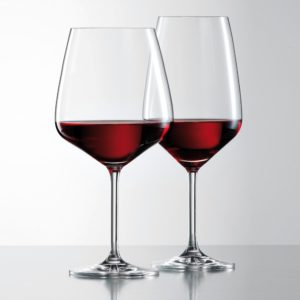The wine hides different flavors, which come in suitable glasses to full development.
Which glass for which wine?
A good wine requires a good glass! A good glass is colorless, wafer-thin and clear; It has a bulbous shape, which is slightly tapered towards the top. In principle also applies: Different wines require different glass forms. Because only in the right glass, the bouquet, so the alcohol-bound fragrances and flavors, unfold at its best.
 To enjoy wine, the right glasses – whether in the restaurant or at the barbecue party.Photo: Adobe Stock
To enjoy wine, the right glasses – whether in the restaurant or at the barbecue party.Photo: Adobe Stock Burgundy Cup and Bowl. Photo: Schott Zwiesel
Burgundy Cup and Bowl. Photo: Schott ZwieselBurgundy Cup: In this voluminous goblet, the noble drop develops its full aroma. Large plants bloom in this glass and reveal even the finest nuances. A Pinot Noir or Pinot Noir has a lot of fruit and fine taste facets, which require a slightly larger glass and develop particularly well here.
Burgundy Bowl: From this classic, the wine flows concentrated on the tongue. The aromas of the fruit and the elegant nuances are enhanced and condensed to a harmonious overall picture.
Bordeaux Cup: The typical scents of a cedarwood and leather bordeaux, as well as its rather discreet fruit, accentuated by pronounced tannins, are brought to life in a voluminous glass. The complexity of its concentrated aromas is demonstrated by this glass.
White wine goblet: Young white wines unfold their freshness in this glass, with mature wines the spicy note is more effective. At the same time, fruit and acid stay in balance.
Rosé wine goblet: Rosé wines are usually drunk young. This slender, curved glass emphasizes the aromas, harmonizing fruit and freshness. The delicate bitter finish gets more expression.
 Infographic: wine friends
Infographic: wine friends




